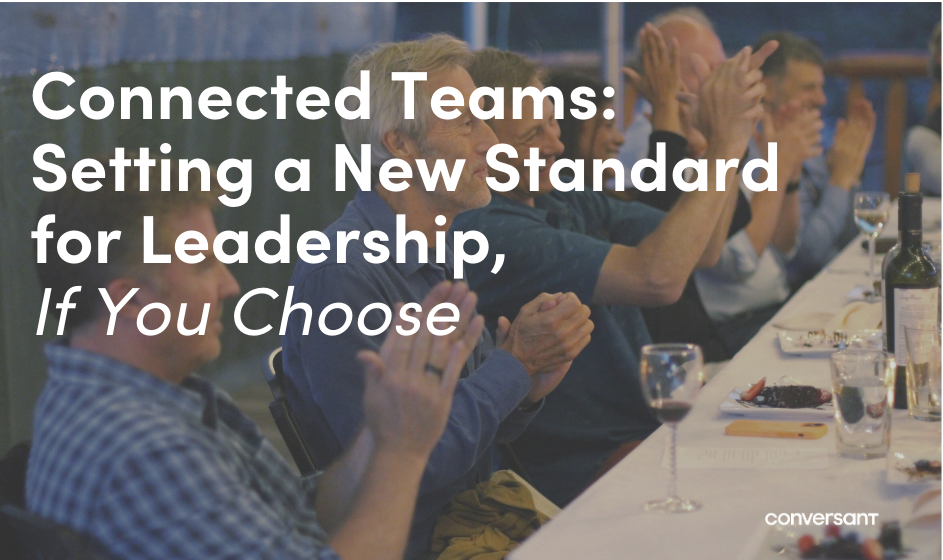Over many years of experience with work, sports and volunteering, the idea that “we are a team” has almost always been operating in many of the participants mindsets. You might hear someone say something like this out loud, but surely the idea that “we are supposed to be a team” is usually operating when a group of people come together in an organization whether it is said or not. Over time I have realized that the automatic belief that having multiple people involved in something means we are a team, can cause a lot of problems. Instead, consciously distinguishing different ways of naming sets of people, can help by allowing us to choose what we want our focus to be on, and then work to elevate and grow towards that goal.
I have experienced at least three distinct types of organizations for sets of people: Group, Team, & Connected Team.
Most organizations that publish a hierarchy/org chart assume that if several people report to a single boss, then that group (the boss and direct reports) is considered a team. This then has the “team members” assume what should and shouldn’t be happening within that set of people and comparing them to their expectations of a team. In basketball, it is common in a pickup game for someone to join four other people on a “team”. I can’t count the number of times that this was obviously a mistake. I joined the other four players only to have one or two of them operate as if they were solo acts, or at best a team made up of the two. These solo acts are then judged by the others as being “ball hogs”. Some players are frustrated that we aren’t operating as a team, while others seem to just be fine operating and playing however they choose. The same thing happens in professional organizations. Each person brings to the group a predefined (and usually unspoken) idea that this should be a team and how it should operate.
The downsides of all of this projection and assuming might be obvious, yet is probably worth discussing. For me, frustration has been the primary experience when I’ve been in these situations. What I’ve observed, almost any time people operate in an environment where they are expecting something more or different than what is occurring, many participants end up experiencing anxiety, frustration and even anger.
I have found that a simple distinction can both provide a lot of relief to the above situation, and can also raise the bar for developing both individually and organizationally. The distinction between Group, Team, and Connected Team can be very useful when looking at a group of people in an organizational system. The distinction is both useful at assessing current state, discussing and deciding where we want to go, and then planning on and taking action to learn and grow.
Group: a set of people in an organization that are primarily responsible for their own responsibilities with little to no need to understand what the others are responsible for and little need to work together. A group may have a physical connection and often lacks a significant emotional relatedness. Leading a group is often focused on sharing information from above with limited need for the group to engage with that information.
Team: a set of people in an organization whose work is interrelated and being sure not to overlap in roles and responsibilities is important. This cognitive relationship to each other with clear boundaries can create efficiencies in an organization. The team may care for, respect and be supportive of each other, yet it is not as necessary as it is with a connected team.
Connected Team: A connected team has a deep connection to the shared purpose and results of the team. Each team member has a place and a personal relationship to the purpose such that a significant amount of their attention is paid to the purpose and how “we” are all working towards that purpose. A common attribute of a team with this level of connection is contributing towards the shared purpose vs. protecting what is in my function or silo. In a highly connected team, it is not unusual to hear people talking about how to make their teammates’ jobs (including the leader) easier.
Image 1: This appears to be at least a team. They are working on something together (shared goals) and are coordinating action and apparently cooperating.
Image 2: This may be a connected team or at team on the verge of being a connected team. Like the first pic, they are working together. The celebration makes it look as if they are working on more than a shared goal. They appear to also have an emotional connection.
If I were reading this right now for the first time, I might think that becoming a team or a connected team may take a lot of effort and could be quite challenging. If so, I’m glad! Becoming a team or a connected team is not just granted to us. It takes real energy, attention and work. At Conversant we say that “the conversations are the work”, or sometimes “the conversations are the work of leadership”. The work of these conversations can be daunting when thinking about the descriptions above. That said, I recommend starting these conversations with a few questions. These questions can be brought by a leader or team member to the rest of the participants. The idea is to hear what each person thinks and feels to get a sense of what each person’s perspective is and then to have choices about how to improve. Below are several questions for yourself as a leader or for a team to discuss together. When having others answer or engage in answering these questions, it will be helpful to present to them the distinction of group, team and connected team. Perhaps you can share this article with them as a pre-read. Here are the questions:
- Are we a group, a team, or a connected team? What has you label it that way?
- Is there a need for us to operate as a team or a connected team?
- Does the organization need us to operate as a team, or is being a group acceptable? (and, being a group is often plenty, depending on what is needed from the set of people)
- What steps could we take to move towards becoming a team? Or, what steps could we take to move towards becoming a connected team?
- Would aligning on what each of us does and is responsible for help us execute our jobs better?
- Would being aware of and sensitive to what’s important to each of us operate better as well as be more engaged?
What would you call the set of people you work with? Might it be worth it to engage with the others about the distinction between Group, Team and Connected Team?

